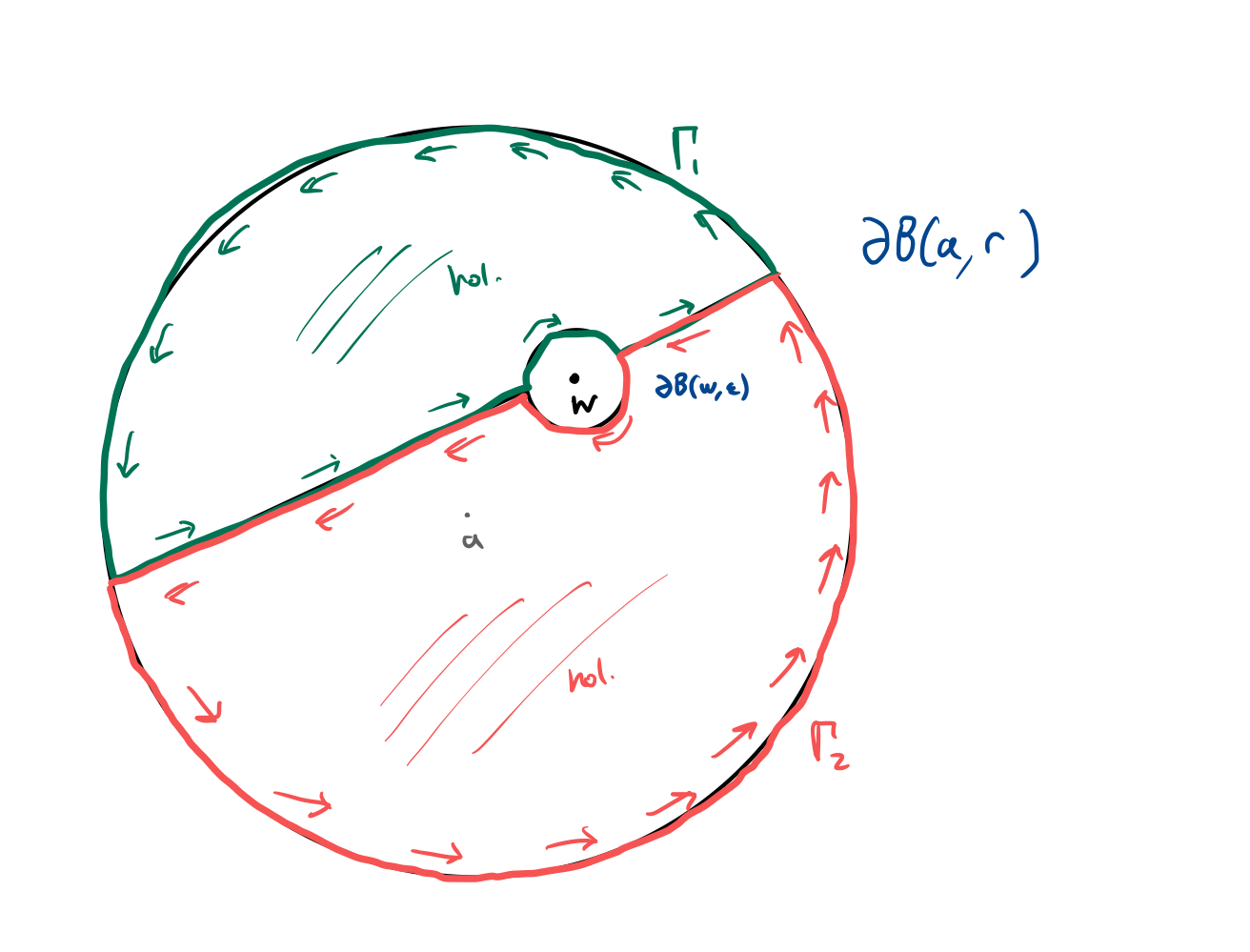Complex Analysis MT23, Cauchy's integral formula
Flashcards
Can you state the “circle” form of Cauchy’s integral formula?
Suppose
- $U$ open set
- $f : U \to \mathbb C$ holomorphic
- $U \supseteq \bar B(a, r)$
Then for all $w \in B(a, r)$, we have
\[f(w) = \frac{1}{2\pi i} \int_\gamma \frac{f(z)}{z-w} \text dz\]where
\[\gamma(t) = a + re^{2\pi i t}\]Quickly prove the “circle” form of Cauchy’s integral formula, i.e. if
- $U$ open set
- $f : U \to \mathbb C$ holomorphic
- $U \supseteq \bar B(a, r)$
then for all $w \in B(a, r)$, we have
\[f(w) = \frac{1}{2\pi i} \int_\gamma \frac{f(z)}{z-w} \text dz\]
Draw a picture: consider contours $\Gamma _ 1$ and $\Gamma _ 2$ where we have a disc about $a$, with some point $w$ on the inside, and $\Gamma _ 1$ loops around a small $\varepsilon$-bump on the outside of $w$ and half of the circle, and $\Gamma _ 2$ loops around the other side.

Then, by additivity properties of the path integrals,
\[\int_{\Gamma_1} \frac{f(z)}{z - w} \text d z + \int_{\Gamma_2} \frac{f(z)}{z - w} \text dz = \int_{\gamma(a, r)} \frac{f(z)}{z - w} \text d z - \int_{\gamma(w, \varepsilon)} \frac{f(z)}{z-w} \text dz\]But by Cauchy’s theorem the integrals on the LHS are $0$, so we have
\[\begin{aligned} \int_{\gamma(a, r)} \frac{f(z)}{z - w} \text d z &= \int_{\gamma(w, \varepsilon)} \frac{f(z)}{z-w} \text dz \\\\ &= \int_{\gamma(w, \varepsilon)} \frac{f(z) - f(w)}{z - w} \text d z + f(w)\int_{\gamma(w, \varepsilon)} \frac{1}{z-w} \text d z \\\\ &= \int_{\gamma(w, \varepsilon)} \frac{f(z) - f(w)}{z - w} \text d z + f(w) \times 2\pi i I(\gamma, w) \end{aligned}\]but then, since $f$ is holomorphic at $z = w$, remaining integral on the RHS must tend towards $0$ as $\varepsilon \to 0$, hence it follows:
\[f(w) = \frac{1}{2\pi i}\int_{\gamma(a, r)} \frac{f(z)}{z -w} \text d z\]Suppose $U$ is an open set of $\mathbb C$ and $(f _ n)$ is a sequence of functions defined on $U$. What does it mean for $f _ n \to f$ uniformly on compacts?
For every compact subset $K$ of $U$, the sequence $(f _ n \vert _ K)$ converges uniformly to $f _ K$.
It is true that if $f _ n : U \to \mathbb C$ is a sequence of holomorphic functions (where $U$ domain), then if $f _ n \to f$ uniformly, $f$ is holomorphic. However, we can actually weaken this condition. What change actually allows this to be true for a wider class of functions?
$f _ n \to f$ only has to converge uniformly on compact subsets of $U$.
Winding number form of Cauchy’s integral formula
Can you state the winding number form of Cauchy’s integral formula, and why this is more powerful than the original form?
Suppose
- $f : U \to \mathbb C$ holomorphic
- $\gamma$ closed path in $U$ (i.e. $I(\gamma, z) = 0$ for all $z \notin U$)
Then, for all $z \in U \setminus \gamma^\star$:
\[\int_\gamma f(w) \text dw = 0\](a form of Cauchy’s theorem), and
\[\int_\gamma \frac{f(w)}{w - z} \text d w = 2\pi i I(\gamma, z)f(z)\]Better since it works for any domain where $\gamma$ lies in domain.
Quickly-ish prove that if
- $f : B(0, r) \to \mathbb C$
- $f$ holomorphic
then
- $f$ is analytic on $B(0, r)$
by using Cauchy’s integral formula. Don’t worry about justifying that the geometric series converges or that we can interchange the order of sums and integration.
Quickly prove that if $U$ is a domain and $f _ n : U \to \mathbb C$ is a sequence of holomorphic functions, then if $f _ n \to f$ uniformly on compacts, then $f$ is holomorphic.
$f$ is continuous: Pick some $a \in U$, then since $U$ is open, $\exists r > 0$ s.t. $B(a, r) \subseteq U$. But then $K = \overline B(a, r/2) \subseteq U$, and $f _ n \to f$ uniformly on $K$, so $f$ is continuous on $K$, and so continuous at $a$.
$f$ is holomorphic: Pick some $w \in U$ and again find $r > 0$ such that $B(w, r) \subseteq U$. Then $B(w, r)$ is convex, so Cauchy’s theorem shows that for every closed path $\gamma: [a, b] \to B(w, r)$ we have
\[\int_\gamma f_n(z) \text dz = 0 \quad \forall n \in \mathbb N\]But $\gamma^\star = \gamma([a, b])$ is a compact subset of $U$. Hence $f _ n \to f$ uniformly on $\gamma^\star$. It then follows
\[0 = \int_\gamma f_n(z) \text dz \to \int_\gamma f(z) \text dz\]So the integral of any closed path in $B(w, r)$ is zero. Then by Morera’s theorem, $f$ is holomorphic on $B(w, r)$.
Prove, by appealing to Liouville’s theorem, the Fundamental Theorem of Algebra:
Suppose that $p(z) = \sum^n _ {k = 0} a _ k z^k$ is a non-constant polynomial where $a _ k \in \mathbb C$ and $a _ n \ne 0$. Then there is a $z _ 0$ for which $p(z _ 0) = 0$.
Suppose that $p(z) = \sum^n _ {k = 0} a _ k z^k$ is a non-constant polynomial where $a _ k \in \mathbb C$ and $a _ n \ne 0$. Then there is a $z _ 0$ for which $p(z _ 0) = 0$.
Todo, consider $1/p$, and use the fact that if it were bounded then Lioville’s theorem would imply that it was constant.